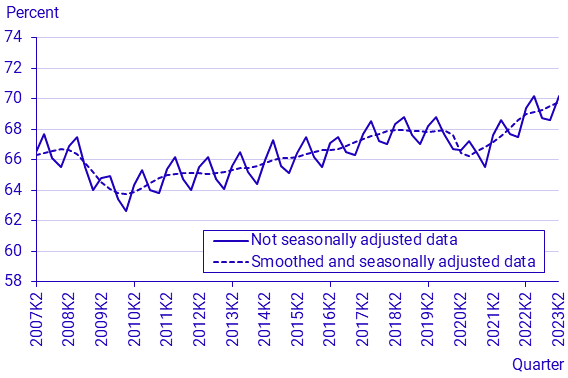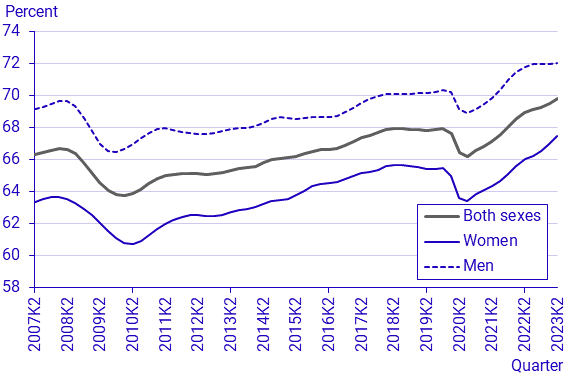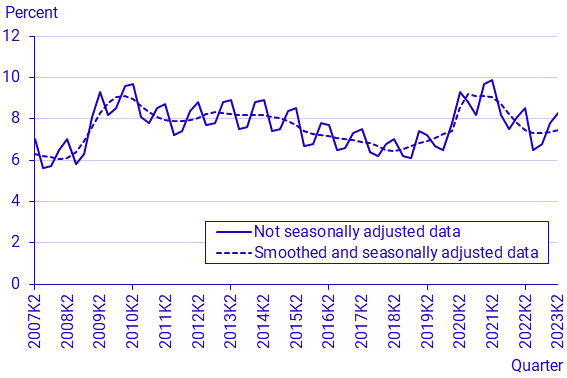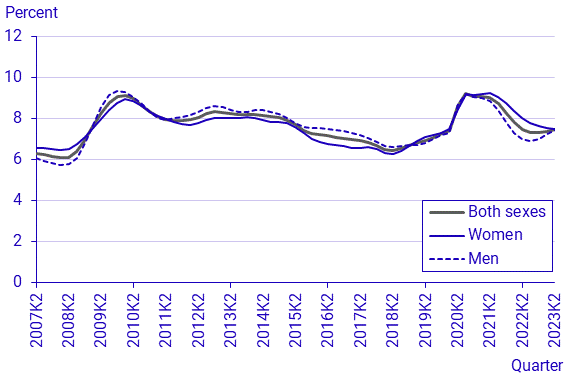Labour Force Survey (LFS), second quarter 2023
Employment continued to increase during the second quarter
Statistical news from Statistics Sweden 2023-08-17 8.00
In the second quarter of 2023, there were 5 315 000 employed persons, not seasonally adjusted. This is an increase of 86 000 persons compared to the second quarter of 2022. The average number of hours worked per week amounted to 159.2 million hours. There were 481 000 unemployed persons, corresponding to an unemployment rate of 8.3 percent. Seasonally adjusted and smoothed data indicates an increase in both the number and share of employed. The seasonally adjusted and smoothed unemployment rate increased and amounted to 7.5 percent.
- We can see that both employment and the labour force increased during the second quarter of 2023 as well. The number of employees increased while long-term unemployment continued to decrease. Overall, this indicates that the labour market continued to be strong during the second quarter, says Charlotte Breitz, statistician at the Labour Force Surveys at SCB.
The labour force
The number of persons in the labour force aged 15-74 years was 5 795 000 in the second quarter of 2023, not seasonally adjusted, an increase of 84 000. The number of women in the labour force amounted to 2 756 000, an increase with 44 000, and the number of men was 3 039 000, an increase with 40 000. The relative labour force participation rate increased by 0.7 percentage points to 76.5 percent. Among women the labour force participation rate amounted to 74.1 percent and among men it was 78.9 percent.
Seasonally adjusted and smoothed data shows an increase in the number and the share of persons in the labour force compared to adjacent quarters. There were 5 711 000 persons in the labour force, which corresponds to 75.4 percent of the population.
Employment
In the second quarter of 2023, there were 5 315 000 persons aged 15–74 in employment, not seasonally adjusted, which is an increase of 86 000 compared to the corresponding quarter a year ago. This corresponds to an employment rate of 70.2 percent, an increase of 0.8 percentage points. The number of employed women increased by 60 000 to 2 530 000 and the number of employed men amounted to 2 785 000. Among women, the employment rate increased by 1.3 percentage points to 68.0 percent and among men it was 72.3 percent. There were 562 000 young people aged 15–24 years in employment. The employment rate for people aged 15-24 was 47.5 percent.
Seasonally adjusted and smoothed data indicates an increase in the number and share of employed persons compared to adjacent quarters. In the second quarter of 2023, there were 5 286 000 employed persons, which corresponds to an employment rate of 69.8 percent.
Employees
In the second quarter of 2023, there were 4 792 000 employees, not seasonally adjusted, which is an increase of 77 000 compared to the corresponding quarter of the previous year. Among those, 2 382 000 were women, an increase of 63 000, and 2 410 000 were men. There were 4 055 000 permanent employees, an increase of 114 000. Among permanent employees, the number of women increased by 84 000 to 1 972 000 and the number of men was 2 083 000. There were 737 000 temporary employees. Among them 410 000 were women and 327 000 men.
Compared to adjacent quarters, seasonally adjusted and smoothed data shows an increase in the number of employees and permanent employees and a decrease in temporary employees. According to seasonally adjusted and smoothed data, the number of employees was 4 765 000. The corresponding figure for permanent employees was 4 046 000 and for temporary employees 719 000.
Hours worked
The average number of hours worked per week in the second quarter of 2023 amounted to 159.2 million hours, not seasonally adjusted. According to seasonally adjusted and smoothed data, the number of hours worked averaged to 158.4 million per week.
The majority of employed persons have an agreed working time of 35 hours or more per week, that is, full-time work. In the second quarter of 2023, 4 157 000 persons worked full time. Among them 1 823 000 were women and 2 334 000 were men. In total, 244 000 persons worked short part-time (1–19 hours), and the number of persons who worked long part time (20-34 hours) amounted to 612 000 persons. 1)
The average actual hours worked among employed persons aged 15–74 years decreased by 0.5 hours and amounted to 30.0 hours per week in the second quarter of 2023. Women worked 27.7 hours per week, a decrease by 0.4, and men worked 32.0 hours per week, a decrease by 0.6.
1) Agreed working time in 2021 and 2022 excludes secondary jobs, this because the agreed working time in secondary jobs has not been collected since the implementation of the EU regulation 2019/1700. As of January 2023, the question regarding agreed working time in secondary jobs was reintroduced and total agreed hours worked are again reported in the Swedish LFS. However, comparisons with the corresponding quarter of the previous year are excluded during 2023.
Underemployment
Among employed persons aged 15–74, 328 000 were underemployed in the second quarter of 2023. This corresponds to an increase of 37 000 compared to the second quarter of 2022. The number of underemployed women was 160 000 and the number of men increased by 23 000 to 169 000. Underemployed persons accounted for 6.2 percent of employed persons.
Unemployment
In the second quarter of 2023, there were 481 000 unemployed persons aged 15–74, not seasonally adjusted. This corresponds to an unemployment rate of 8.3 percent. There were 226 000 unemployed women and 254 000 unemployed men. The unemployment rate for women was 8.2 percent and the male unemployment rate was 8.4 percent.
For persons aged 15–74, seasonally adjusted and smoothed data shows an increase in the number and share of unemploye persons compared to adjacent quarters. The number of unemployed amounted to 426 000 in the second quarter 2023, which corresponds to an unemployment rate of 7.5 percent.
There were 118 000 long-term unemployed persons (unemployed for at least 27 weeks) aged 15–74 years in the second quarter of 2023, a decrease of 28 000 compared to the second quarter of 2022. Among long-term unemployed persons, the number of women decreased by 18 000 to 49 000 and the number of men amounted to 70 000.
There were 201 000 unemployed young persons aged 15–24, not seasonally adjusted. This corresponds to an unemployment rate of 26.3 percent. Among unemployed young people, 137 000 persons were full-time students. For persons aged 15–24, seasonally adjusted and smoothed data shows an increase in the number of unemployed persons compared to adjacent quarters. The number of unemployed young persons amounted to 151 000, corresponding to an unemployment rate of 21.8 percent.
Not in the labour force
The group 'not in the labour force' includes persons who are not classified as employed nor as unemployed. In the second quarter of 2023, there were 1 776 000 persons not in the labour force, which is a decrease of 46 000 compared to the second quarter of 2022. The number of women not in the labour force was 963 000 and the number of men was 813 000.
Among persons not in the labour force, the number of retired persons decreased by 31 000 to 846 000, 443 000 were full-time students and 289 000 persons reported that they were on long-term sick leave.
Latent job seekers
There were 216 000 latent job seekers aged 15–74 years in the second quarter of 2023. Among them, 108 000 were women and 108 000 were men. Among young people aged 15–24, the number of latent job seekers was 96 000.
Unused labour supply
Unemployed persons, underemployed persons and latent job seekers together comprise the unused labour supply. In the second quarter of 2023, the unused labour supply averaged 23.3 million hours per week. The unused labour supply corresponds to 583 000 full-time employments with 40-hour work weeks.
Labour market for persons aged 20-64 years
The population presented by the LFS is comprised of persons aged 15–74 years. However, labour market participation among younger and older in this age group is considerably lower for natural reasons, as this group contains large shares of students and retired persons. To better approach what can be seen as the core of the actively working population, the situation of the age group 20–64 years is described in the following section.
The relative labour force participation rate among persons aged 20–64 years amounted to 88.9 percent in the second quarter of 2023, not seasonally adjusted. For women, the relative workforce participation rate was 86.7 percent, and for men it was 91.1 percent. Seasonally adjusted and smoothed data shows an increase in the labour force participation rate, which amounted to 88.3 percent.
In the second quarter of 2023, the share of employed persons aged 20–64 was 83.2 percent, not seasonally adjusted. For women, the corresponding figure was 81.2, an increase of 1.2 percentage points, and for men it was 85.2 percent. Seasonally adjusted and smoothed data shows an increase in the employment rate compared to adjacent quarters. The employment rate amounted to 82.8 percent.
According to not seasonally adjusted data, the unemployment rate in the age group 20–64 amounted to 6.4 percent in the second quarter of 2023. The unemployment rate among women was 6.3 percent and for men it was 6.5 percent. According to seasonally adjusted and smoothed data the unemployment rate was 6.2 percent.
Swedish born and foreign born persons aged 20–64 years
The relative labour force participation rate among Swedish born persons aged 20–64 years was 89.5 percent in the second quarter of 2023, not seasonally adjusted. Among Swedish born women, the participation rate amounted to 88.3 percent, and among Swedish born men it was 90.5 percent. Among foreign born persons aged 20–64 years, the participation rate was 87.5 percent, an increase of 1.9 percentage points compared to the corresponding quarter in 2022. The corresponding figure was 82.5 percent among foreign born women, and 92.5 percent among foreign born men, an increase of 2.3 percentage points. Seasonally adjusted and smoothed data shows an increase in the labour force participation rate among Swedish born as well as among foreign born persons. The labour force participation rate amounted to 88.7 percent among Swedish born persons and 87.0 percent among foreign born persons.
In the second quarter of 2023, the share of employed Swedish born persons aged 20–64 was 86.1 percent, not seasonally adjusted. Among Swedish born women, the employment rate was 85.1 percent and among Swedish born men the employment rate was 87.0 percent. Among foreign born persons, the employment rate was 75.6 percent, an increase of 3.1 percentage points. The employment rate among foreign born women was 71.1 percent, an increase of 4.7 percentage points. Among foreign born men it was 80.1 percent. Seasonally adjusted and smoothed data shows an increase in the employment rate compared to adjacent quarters for foreign born persons. The employment rate was 85.6 percent among Swedish born and 75.2 percent among foreign born persons.
The relative unemployment rate among Swedish born persons aged 20–64 years was 3.8 percent in the second quarter of 2023, not seasonally adjusted. Among Swedish born women, the unemployment rate was 3.7 percent, and the male unemployment rate was 3.9 percent. The unemployment rate among foreign born persons decreased by 1.7 percentage points to 13.6 percent. Among foreign born women it was 13.7 percent, a decrease of 4.2 percentage points, and among foreign born men the corresponding number was 13.5 percent. According to seasonally adjusted and smoothed data, the unemployment rate for Swedish born increased compared to adjacent quarters and amounted to 3.5 percent. Among foreign born, the seasonally adjusted and smoothed unemployment rate decreased compared to adjacent quarters and was 13.6 percent.




Source: Statistics Sweden
Definitions and explanations
Since the LFS is a sample survey, the results are subject to some uncertainty. The LFS basic tables contain uncertainty figures and refer to non-seasonally adjusted data.
Seasonally adjusted and smoothed data (trend values): data in which normal seasonal variations have been removed, then smoothed to reduce sampling error and short-term variations. Seasonally adjusted and smoothed data may be revised following new monthly outcomes and usually does not coincide with non-seasonally adjusted data. Seasonally adjusted and smoothed data is not to be compared with non-seasonally adjusted data.
More detailed results are available in the form of figures and tables on employed persons, hours worked, unemployed persons and more, on Statistics Sweden’s website.
Next publishing will be
2023-08-25, at 08:00.
Feel free to use the facts from this statistical news but remember to state Source: Statistics Sweden.
